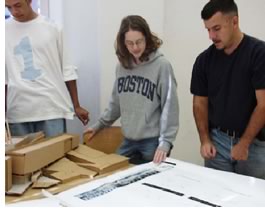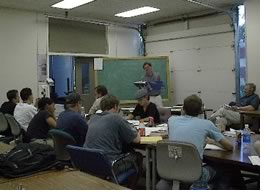
A U.Ky. professor asks in studio: "How does this design meet code?"
by John R. Groves, PhD, AIA
 Early
in my career, I recognized the tremendous impact of code compliance on
design development. I had recently completed requirements for licensure
in 1977 when the disastrous conflagration at the Beverly Hills Supper
Club in Southgate, Ky., took 165 lives. The fatalities were due in large
part to panic and irrational behavior—behavior that possibly could
have been controlled through a more carefully thought out design for egress.
Because the Beverly Hills Supper Club was a collection of additions over
the years, both the application of the code in the "big picture"
as well as the application of common sense intuitive fire safety measures
had received insufficient attention. The application of the code at these
two levels is fundamental to my teaching in the studio, the professional
class, and related elective courses to this day.
Early
in my career, I recognized the tremendous impact of code compliance on
design development. I had recently completed requirements for licensure
in 1977 when the disastrous conflagration at the Beverly Hills Supper
Club in Southgate, Ky., took 165 lives. The fatalities were due in large
part to panic and irrational behavior—behavior that possibly could
have been controlled through a more carefully thought out design for egress.
Because the Beverly Hills Supper Club was a collection of additions over
the years, both the application of the code in the "big picture"
as well as the application of common sense intuitive fire safety measures
had received insufficient attention. The application of the code at these
two levels is fundamental to my teaching in the studio, the professional
class, and related elective courses to this day.
In the late 1970s, I was asked to help formulate and become the deputy commissioner, and later the commissioner, of a regulatory agency in Kentucky that sought to eliminate the conditions that in part led to the supper club fire. That experience motivated me to impart to students an abiding appreciation for the tools architects have to protect health, safety, and welfare.
 Incorporating
codes into curriculum
Incorporating
codes into curriculum
The emphasis of the academy continues to be on design and the development
of an individual student's design philosophy and methodology. However,
when we introduce the tasks associated with developing basic construction
documents, then codes automatically become part of the process.
Students are interested, stimulated, motivated, and challenged by design issues. From my experience, it is my view that one hook for teaching codes effectively in colleges of architecture is integrating the code process with design issues in the studio. Of course, adding building code requirements to the process of design at the student level is going to increase the complexity. Nonetheless, my experience shows that at the fifth year and at the graduate level, it's appropriate to challenge the students to incorporate a large portion of the spectrum of complexity associated with real-world building design.
Over the years, my colleagues and I have tried a number of different approaches to building-code education: integrating building code components into professional practice classes, including a semester-long professional practice class, and adding parts of building code study to an advanced professional practice class. Most recently—and, I think, most successfully—we have made code issues an integral part of our "comprehensive studio," in which mainly fifth-year students (ours is a five-year professional degree program) are expected to develop their presentation documents to the design development stage, in AIA contract terminology. This more comprehensive approach gives us the opportunity to talk in some detail about how codes apply to their schemes, including selection of materials, routes of egress and travel distance, and other major building code topics. The studio allows the students to continue to develop their own design philosophy but at the same time challenges them to be pragmatic in applying the fundamentals of the building code and, therefore, to explain and justify in greater detail how they developed their design solutions.
 Teaching
materials
Teaching
materials
Instruction in the application of building codes may
seek to impart a working knowledge that is readily applicable to the document
production process. However, my view is that courses that use the building
code as a textbook, in courses outside of the studio, are at a disadvantage.
I know all too well that faculty are often bound by the three-credit hour
format and I also know that many standalone code courses have been and
continue to be successful. My experience, having tried it both ways, is
that teaching code concepts as an integral part of the design studio works
best. Using this method, the code will not always be revealed in great
detail. But I see the role of the design faculty as requiring students
to incorporate important code concepts into their work, especially at
the upper levels. It helps, of course, for faculty to impart technical
and detailed aspects of the code to students and to use case studies,
but it is the performance rather than prescriptive aspects of the codes
that the students absorb most readily. In the end, our students should
have a respect for building codes as an indispensable element in the creation
of good architecture.
To convey these ideas, I use: Architecture: Space Form and Order by Francis Ching; Why Buildings Stand Up, by Mario G. Salvadori; and, as an external reading assignment, a book describing the Beverly Hills Supper Club fire. I like the Ching book because it is in a language that appeals to students. It does not address codes per se, but it encourages students to find solutions through graphic manipulation. I find this manner of engaging the building code to reinforce the visual learning process that is so much a part of teaching students of architecture. Of course, the Kentucky Building Code, which is based on the BOCA Building Code, is never far away. But it is not the starting point. In addition, works by prominent and trend-setting architects often serve as mini case studies for code applications. In these code discussions, when we can, we try to learn about the project program, the project delivery process and other particulars. Especially, when we look at "signature architects", this form of analysis tends to underscore the fact that to become a work of architecture, even the most leading edge design must be reconciled with building code requirements.
I find that among building types, large places of assembly are often the most instructional for code purposes. Conditions that can create panic, group think, and other potentially catastrophic events can be fairly easily illustrated through a discussion of the code dynamics applicable to large scale assembly buildings (not to mention the structural and mechanical requirements and other areas contained in comprehensive building codes). The main goal here is to get students thinking. One of my techniques is to ask students, "What would happen in our classroom right now, as we are watching slides, with all the shades down, if the power were suddenly to go off and thick smoke filled the room? Our classroom has three exits, so how would you exit this room?"
 "Well,"
they respond, "we would go out the way we came in."
"Well,"
they respond, "we would go out the way we came in."
And that, I point out, is what typically happens in a fire emergency. In our case, up to 150 people in this room will head for the same door. So we turn to whether that door would allow orderly egress for 150 people. It isn't pleasant talking about the Beverly Hills Supper Club fire, where about 50 people were pushed into one doorway and were asphyxiated by smoke in the impassable crush long before the fire reached their location.
We also talk about panic events at soccer stadiums and other current events. We talked about the Twin Towers attack last year, in which, in the time available, many people were able to get out in a fairly orderly fashion, by following the procedure intended by the design.
Beyond the design itself, we also talk about selection of materials. Students come to understand that it is the responsibility of the architect to select all materials included within the specifications, understand the performance criteria of any material, and use independent testing rather than proprietary information from the vendor or manufacturer. Mainly we try to teach students to ask the right questions to get the right answers.
As a faculty member in a college of architecture teaching design and other courses, my goal is for our students to graduate with a broad but essentially intuitive sense of the code, enhanced with case studies and application in their design studio work. If we do our job, they are prepared then to develop as interns and learn the code in greater detail in preparation for the ARE and practice.
Integrating code instruction into the design studio is not particularly easy. It requires preparation and homework by both faculty and students. If we are successful, however, we may ask our students, "Can you justify your design in terms of basic code expectations?" and we can be assured that they will have given thought to the response.
Copyright 2002 The American Institute of Architects. All rights reserved.
![]()
|
Groves is currently an associate professor of architecture at the University of Kentucky and the Archives Fellow at the CRS Center at Texas A&M University. The emphasis of his research is on the meaning of leadership in architecture. Groves is also the former adjutant general of the Kentucky National Guard. |
|